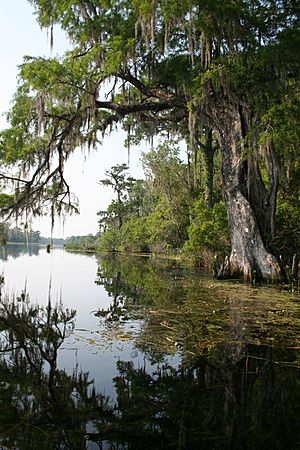Wacissa River facts for kids
The Wacissa River is a beautiful, clear river in Jefferson County, Florida. It gets its water from many large, natural springs that bubble up from the ground. These springs are located just south of the town of Wacissa.
From where it starts, the river flows about 12 miles (19 km) south. It winds through a big swamp filled with cypress trees. After that, it splits into many smaller streams that eventually join the Aucilla River. The Wacissa River is an important natural area. It is managed by the Florida Fish & Wildlife Conservation Commission as part of the Aucilla Wildlife Management Area. The state of Florida has even called it an "Outstanding Florida Waterway" because of its special natural beauty and importance.
Contents
What Are the Wacissa Springs?
The Wacissa River is fed by a group of amazing natural springs. These springs are found in a low-lying forest area. This area is below a line of hills to the north called the Cody Scarp.
How Many Springs Feed the River?
There are at least 12 known springs that feed the Wacissa River. They are spread out along the first 1.5 miles (2.4 km) of the river. The land around the river is mostly flat and swampy. It's only a little bit higher than the river itself. The area right next to the river and springs is covered in thick forests. You'll see cypress trees, oak trees, and some pine trees there.
Water Temperature and Flow
The water in the Wacissa River is usually clear and cool. It stays around 21 °C (70 °F) on average. Because there are so many springs and a lot of water plants, it's hard to measure how much water each spring puts out. However, the river's average flow from 1971 to 1974 was about 389 cubic feet per second. That's a lot of water!
Wildlife and Plants of the Wacissa River
The Wacissa River is home to many different kinds of plants and animals. It's a great place to see Florida's natural beauty.
Plants You Can Find
The plants here are typical for a freshwater swamp in the southeastern United States. You'll see lots of pond cypress and bald cypress trees along the riverbanks. Other trees include sweetbay, maple, sweet gum, hickory, oak, magnolia, holly, willow, and sabal palms.
The water itself also has many plants. Some non-native plants like Water hyacinth and hydrilla are common in the upper parts of the river. In the spring runs, you might find pickerel weed, arrowhead, elodea, and eel grass. There are also beautiful wildflowers, including different kinds of water lilies.
Animals That Live Here
The Wacissa River is famous for its large number of water birds. You can spot egrets, herons, ibis, osprey, wood storks, limpkins, anhingas, kingfishers, barred owls, and even bald eagles!
Many aquatic animals also live here. Look out for alligators, river otters, turtles, water snakes, and crayfish. The main types of fish are bass, mullet, catfish, red-breasted sunfish, stumpknocker, and gar. You might also find warmouth perch, speckled perch, flier bream, and shellcracker.
History of the Wacissa River Area
The Wacissa River area has a rich history, especially concerning its natural environment.
How the Area Used to Be
According to a report from 1976 by George L. Thurston III, the area around the Wacissa River looked very different two centuries ago. The uplands to the north had open forests of tall longleaf pine trees. West of the river, there was a wild, swampy pineland with rocky areas. This whole region, covering about 400 square miles (1,000 km²), was full of deer, bear, bobcats, wild turkeys, and bobwhites. Billions of migratory birds and waterfowl also visited the area.
Before the Civil War, the river was used a little bit to move cotton by barge from plantations in Jefferson County to Newport. But after the war, this largely stopped, and the area remained mostly untouched. In the late 1800s, the Wacissa area became well-known to bird experts because ivory-billed woodpeckers, which are now very rare, were quite common there.
Changes from Logging
In 1930, timber companies cut down almost all the pine and bald cypress trees in the entire Wacissa watershed. They built tram roads to move the lumber, and these old roads are now many of the dirt roads that lead to the river today.
Cutting down the forest had a big impact. When naturalist Herbert Stoddard, Senior, visited the area in 1932 after being away for some years, he said the entire environment of the lower river had "drastically changed." Instead of the shallow, clear stream he remembered, he found it running high and dark all the time. Apple snails, which need clear, lime-rich water, could only survive in the upper parts of the river near the springs. Birds like limpkins and egrets, which eat these snails, became as rare as the snails themselves.
The River Today
Even though much of the Wacissa forest has been recovering for about 85 years, logging still happens in nearby areas. Large parts of the land next to the river are owned by the St. Joe Company, even though the state of Florida manages them. However, the company has agreed not to cut trees right next to the river.
Today, the Wacissa River is mostly used for fun activities. People enjoy swimming, boating, fishing, and birdwatching here. It's a wonderful place to explore nature and enjoy the outdoors.


